Creating a diverse native plant palette while dealing with deer
Gregg will present Nature’s Sanctuary: Challenges of and Solutions for a SITES Gold Landscape at ELA’s Conference & Eco-Marketplace on March 4.
By Gregg Tepper
West Laurel Hill Cemetery, a level-II accredited arboretum located in Bala Cynwyd, Pennsylvania, features a unique space called “Nature’s Sanctuary.” This one-acre space, which previously served as the cemetery’s dumpsite, now uses a managed successional plan that will gradually transition it from its current state as a sunny meadow to a meadow/woodland combination, and finally, a mature forest. Effective best management practices combined with the incorporation of native herbaceous plants, shrubs, and trees are used to achieve this. This area also obtained SITES Gold certification, making West Laurel Hill the only cemetery in the world to earn such distinction. The focus of this article is on the range of native plant species that are being grown in this one-acre space and doing so with deer pressure.
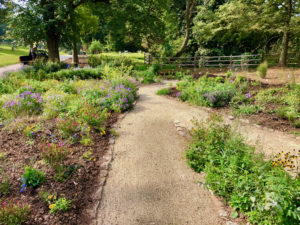
Nature’s Sanctuary features a diverse palette of native plants.
Any site that one gardens has its advantages and challenges. Nature’s Sanctuary has a southern aspect and a gentle slope with both full sun and full shade areas. The soil, which is a mix of heavy clay and clay loam, has been improved by the addition of leaf mulch. Adding leaf mulch with each planting aids in soil moisture retention, helps to suppress weeds, and simultaneously adds organic matter, which, over time, improves fertility and soil structure.
There is, of course, one especially taxing challenge to this location, and that is herbivory by white-tailed deer. So, in choosing native plants, consideration must be given to the plants’ resistance to deer and species diversity, bloom times, heights, textures, and forms. A tall order!
However, that tall order is achievable. The following brief descriptions explain several of the choices made and the attributes.
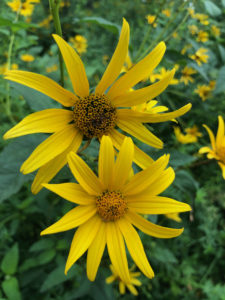
Heliopsis helianthoides, known as False Sunflower, benefits native bees and butterflies.
- Monarda fistulosa, Wild Bergamot, is a highly deer-resistant member of the mint family with pale purple blossoms that appear in mid-summer on two to three-foot stems. The fragrant, nectar-rich blossoms are heavily visited by bumblebees and butterflies over a long period. It’s an easy-to-grow plant that has an open and airy appearance.
- Heliopsis helianthoides, False Sunflower, is a sunflower family member that brings its three-inch yellow blossoms to the early- and mid-summer season on three to five-foot stems and, once it is fully grown, the deer rarely browse it. However, its new growth is sometimes browsed, and this is where applications of deer repellant early on are helpful. Because it’s so easy to grow and blooms prolifically, it can be a mainstay of the summer plant matrix.
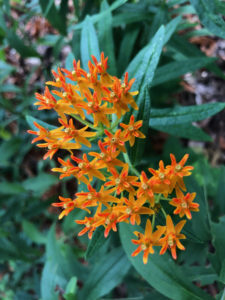
Asclepias tuberosa, which I call Butterfly Flower, is a larval host for Monarch butterflies, and the deer do not eat it!
- Asclepias tuberosa, Butterfly Flower, (I choose to call it “flower” since it is everything but a “weed,” the usual common name), is a member of the milkweed family and the only one without the typical milky sap. An important larval host for the Monarch butterfly and nectar source for many other butterflies and bumblebees, the orange clustered blossoms of this plant steal the show in summer. This hardy and resilient perennial grows roughly one to two feet high, and deer ignore it as a food source. When sited in full sun and well-drained soil, it will be a long-lasting perennial.
- Carex laxiculmis, Spreading Sedge, is a member of the sedge family and is a welcome addition to the shady garden, and thrives in mesic, open woodlands. The narrow, clumping foliage is a medium green. There is a popular trademarked variety called Bunny Blue that features bluish leaves and adds a unique color dimension in full shade to part sun locations. Besides the advantage of being an easy-to-grow evergreen sedge, it’s also not eaten by deer. Its dense crowns divide easily and, once replanted and kept watered, establish successfully.
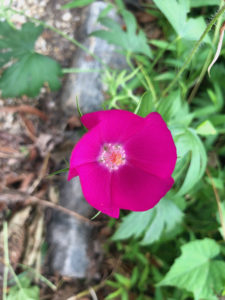
Callirhoe involucrata, known commonly as Wine Cups, is an excellent and very durable ground cover.
- Callirhoe involucrata, Wine Cups, is a mallow family member and typically a low, spreading groundcover that is resplendent with its two-inch wide, deep magenta flowers in May and June. It does well planted on bed edges and along paths and holds its own with slightly taller plants as it often grows up through them. Its growth appears lush, and it thrives in dry, rocky soils in full sun. Deer do browse this, and monthly repellant applications work well and are worth the effort.
- Athyrium angustum, Northern Lady Fern, is a member of the lady fern family that provides finely cut foliage that is deer-resistant and rarely if ever, browsed. This vase-shaped, clump-forming fern is easy to satisfy in well-drained, organic soils and prefers regular moisture. It also responds well to cutting back its older, less attractive fronds in the mid-season, which will be replaced by fresh new growth. There is a red-stemmed form, forma rubellum, well worth adding to the garden. ‘Lady In Red’ is a cultivated variety of this form.
- Viburnum dentatum, Arrowwood Viburnum, is a member of the moschatel family and an easy-to-accommodate and useful native shrub with a fine list of attributes. It grows equally well in full sun to full shade, and its ultimate height and width vary according to light exposure. In full sun situations, it can grow to six to ten feet high and three to five feet wide. This shrub also responds well to pruning for size and structure. Profuse bloom clusters appear in late spring. Fewer blooms are found on shrubs in the shade, but they bloom well, nonetheless. The flowers are followed by blue-black fruits that contain over 40% fat and, once mature, are relished by songbirds. The leaves turn a brilliant orange and red color in fall, adding yet another fine attribute to this shrub. Arrowwood Viburnum leaves are also not browsed by deer, but occasionally they will browse the blooms in spring. There is a variety under the trade name Blue Muffin, a dwarf form growing to a maximum of five to seven feet when mature but is easily pruned to stay smaller. Plant various forms to ensure good pollination and excellent fruit set.
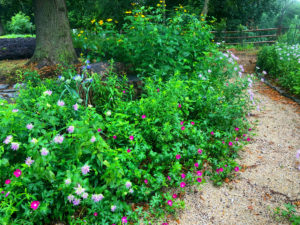
A colorful mix of the yellow Heliopsis helianthoides, pale pink Monarda fistulosa, and magenta Callirhoe involucrata thrives in Nature’s Sanctuary.
It seems that many of our best native plants are heavily browsed by deer, and even those that are typically not, like the Viburnum dentatum above, may have only the flowers eaten. Oh, those blasted deer! There are plants that deer don’t browse, and for other plants, there are repellants such as Deer Stopper and Deer Scram. Deer Stopper is a repellent liquid concentrate and Dear Scram is a granular repellent. I have found the effective application rates are Deer Stopper every 30 days and Deer Scram applied roughly every three weeks. I recommend trying them, and not only for deer, but also to repel rabbits. The combination of the plants and repellants is what I find works as a most effective strategy.
I’ll leave you with this list of the most rewarding outcomes of my experience with Nature’s Sanctuary:
- To grow all native plants, shrubs, and trees in this space and do so with deer pressure.
- To experience the heightened public awareness of the beauty of this naturalistic space.
- To witness the high activity of native bumblebees, wasps, and butterflies as well as seeing birds like the American Robin and the Goldfinch have an active presence.
- To share my knowledge and experience through our newly created Nature’s Sanctuary Intern position.
As always, Happy Gardening!
About the Author
Gregg Tepper is a professional horticulturist, lecturer, consultant, and lifelong native plant enthusiast. After studying Ornamental Horticulture at the University of Delaware and several years creating his own ornamental and native plant gardens, Mr. Tepper started a horticultural maintenance business designing and managing private gardens in southeast Pennsylvania and northern Delaware. He went on to work at Mt. Cuba Center in Hockessin, DE, where he held the positions of Horticulturist, Woods Path Horticulturist, and Director of Horticulture. Subsequently, he was Director of Horticulture and board member of Delaware Botanic Gardens in Dagsboro, DE. He was instrumental in developing the initial horticultural mission, leading the garden steward volunteers, and implementing a two-acre meadow designed by world-renown garden designer Piet Oudolf. Mr. Tepper is now the Horticulturist at the Arboretum at Laurel Hill and West Laurel Hill Cemeteries in Philadelphia, PA, where he manages various display gardens, including Nature’s Sanctuary, a SITES Gold credited landscape. Gregg has lectured extensively in the United States and Great Britain. Also, he is co-author of the book Deer-resistant Native Plants for the Northeast.
***
Each author appearing herein retains original copyright. Right to reproduce or disseminate all material herein, including to Columbia University Library’s CAUSEWAY Project, is otherwise reserved by ELA. Please contact ELA for permission to reprint.
Mention of products is not intended to constitute endorsement. Opinions expressed in this newsletter article do not necessarily represent those of ELA’s directors, staff, or members.

